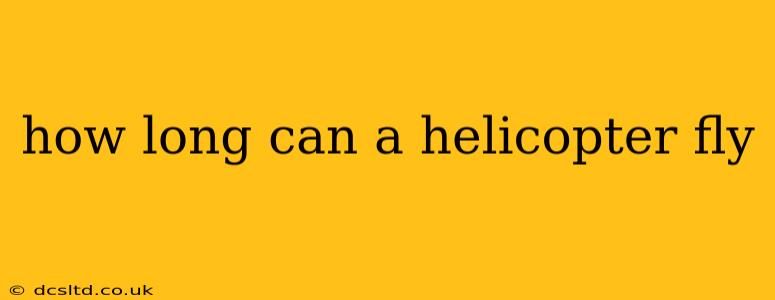How Long Can a Helicopter Fly? The Limits of Rotorcraft Endurance
The simple answer to "How long can a helicopter fly?" is: it depends. There's no single answer, as flight duration for helicopters varies dramatically based on several key factors. Understanding these factors is crucial to grasping the true limits of helicopter endurance.
What Factors Determine Helicopter Flight Time?
Several interconnected factors significantly influence how long a helicopter can remain airborne:
-
Helicopter Model: Different helicopter models possess varying fuel tank capacities, engine efficiencies, and overall designs. A smaller, single-engine helicopter will naturally have a shorter flight time than a larger, twin-engine model. The type of rotor system (single main rotor, tandem rotor, etc.) also plays a role in fuel consumption.
-
Payload: The weight carried by the helicopter significantly impacts fuel consumption. Heavier payloads, such as passengers, cargo, or external loads, require more power and consequently reduce flight time. Even seemingly small weight variations can accumulate and affect endurance.
-
Weather Conditions: Adverse weather, including strong winds, heavy rain, or snow, can drastically reduce flight time. Fighting against headwinds increases fuel consumption, while icing can damage components and necessitate an earlier landing.
-
Flight Profile: The type of flight significantly impacts fuel efficiency. Hovering consumes far more fuel than level flight. Frequent climbs, descents, and maneuvers also increase fuel burn. A helicopter flying a long, straight route at a consistent altitude will have a longer flight time than one performing complex maneuvers.
-
Maintenance and Engine Health: A well-maintained helicopter with properly functioning engines will naturally achieve longer flight times compared to a machine requiring maintenance or experiencing mechanical issues. Regular servicing and inspections are vital for optimal performance and safety.
-
Fuel Type and Quality: Using the correct type of aviation fuel and ensuring its quality are crucial. Substandard fuel can impact engine performance and shorten flight time.
How Long Can Different Types of Helicopters Fly?
While specifics depend on the factors mentioned above, we can offer some general ranges:
-
Small, Single-Engine Helicopters: These might have a flight time ranging from 2-4 hours under ideal conditions. However, this can decrease substantially with increased payload or adverse weather.
-
Larger, Twin-Engine Helicopters: These helicopters generally possess longer endurance, often reaching flight times of 4-6 hours or more, again dependent on the factors mentioned earlier. Their larger fuel capacity allows for extended missions.
-
Specialized Helicopters (e.g., Military or Heavy-Lift): These can have significantly longer flight times, sometimes exceeding 8 hours, thanks to their robust engines and often larger fuel tanks. However, their operational capabilities also greatly depend on the mission specifics.
What About Extended Flight Times?
Achieving extended flight times often involves employing strategies like:
-
Refueling in Flight: Some helicopters are equipped for aerial refueling, extending their operational range and duration significantly.
-
Improved Engine Technology: Advancements in engine technology continuously lead to more fuel-efficient designs, resulting in increased flight times.
-
Advanced Flight Management Systems: Sophisticated flight management systems optimize flight parameters, leading to better fuel efficiency and extended range.
In conclusion, there's no single definitive answer to how long a helicopter can fly. The flight time is highly variable and depends on the aircraft type, its payload, the weather conditions, the mission profile, and the overall state of maintenance. However, by understanding these factors, one can gain a better appreciation for the operational capabilities and limitations of rotorcraft technology.
